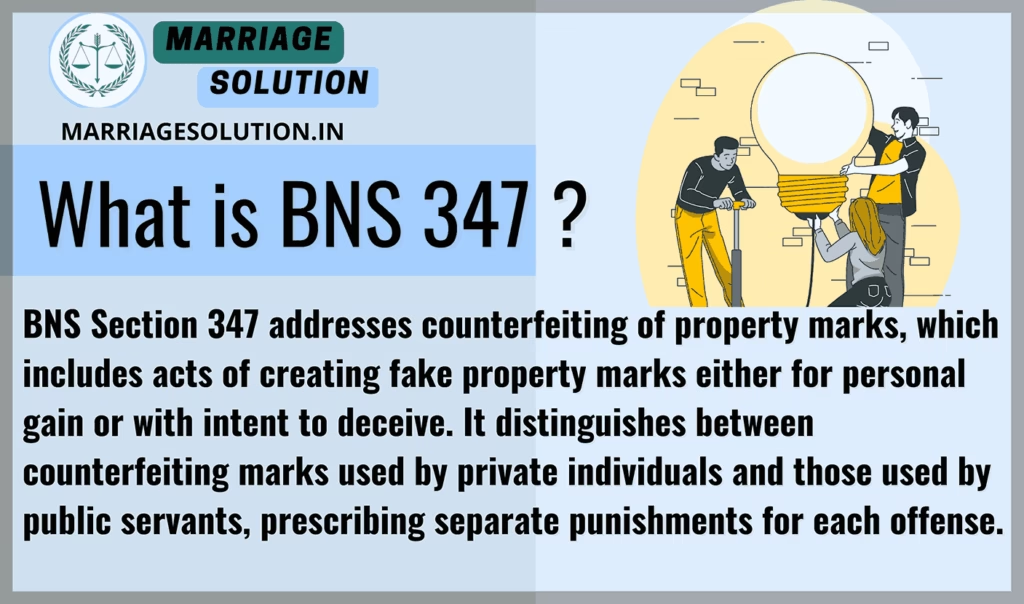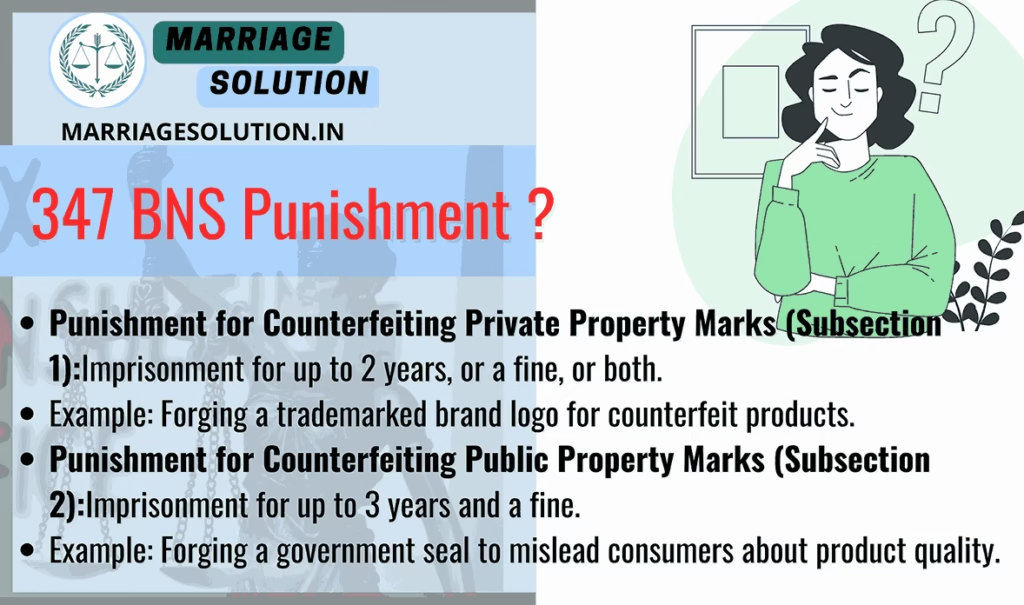Introduction of 347 BNS
347 BNS of the Bharatiya Nyaya Sanhita deals with the counterfeiting of property marks—symbols, logos, or seals that denote ownership, authenticity, or quality of goods. This provision ensures that individuals or businesses cannot create fake property marks to deceive others. It distinguishes between counterfeiting private property marks and public property marks, with stricter punishment for forging government seals or official marks. The law plays a crucial role in protecting intellectual property, consumer safety, and public trust in legal and trade systems.
The Bharatiya Nyaya Sanhita (BNS) Section 347 replaces the old Indian Penal Code (IPC) Section 484.
What is BNS Section 347 ?
BNS Section 347 addresses counterfeiting of property marks, which includes acts of creating fake property marks either for personal gain or with intent to deceive. It distinguishes between counterfeiting marks used by private individuals and those used by public servants, prescribing separate punishments for each offense.

Under Section 347 of the bns act 2023
“Whoever counterfeits any property mark used by another person, or any property mark used by a public servant, intending or knowing it is likely to cause injury, shall be punished— with imprisonment up to two years, or with fine, or with both, for private property marks; and imprisonment up to three years and fine for counterfeiting public servant property marks.”
1. Meaning of Counterfeiting a Property Mark
- Property mark → A symbol, logo, seal, or stamp used to identify ownership, authenticity, or quality of movable property.
- Counterfeiting → Making a false or fake property mark that imitates the original with intent to deceive or harm.
Example → Copying a famous brand’s logo to sell duplicate goods as genuine.
2. Essential Ingredient – Intention to Deceive or Cause Injury
The offense requires intention or knowledge that the counterfeit mark may cause harm.
- Injury here includes:
- Financial loss
- Damage to goodwill or reputation
- Misleading buyers or consumers
- Risk to public safety (fake seals on medicines, food, or machinery)
Example → Using a fake government inspection seal on food packets to show they are “quality tested.”
3. Punishment under BNS Section 347
- Private Property Marks (Subsection 1):
Imprisonment up to 2 years, or fine, or both. - Public Servant Property Marks (Subsection 2):
Imprisonment up to 3 years + fine (stricter due to public trust factor).
This ensures proportionate punishment depending on the nature of the counterfeit mark.
4. Nature of the Offense
- Bailable → Accused can get bail as a matter of right.
- Non-Cognizable → Police need magistrate’s approval before investigation or arrest.
- Trial by:
- Private property mark cases → Any Magistrate.
- Public property mark cases → Magistrate of First Class.
5. Examples of BNS Section 347 in Action
- Example 1 – Business Fraud:
A shopkeeper prints a fake logo of a famous electronics company to sell duplicate products. → Punishable under Section 347(1). - Example 2 – Fake Government Seal:
A counterfeiter uses a forged government quality certification mark (e.g., FSSAI, ISI, BIS) to sell unsafe food. → Punishable under Section 347(2). - Example 3 – Innocent Case (Not Offense):
A small trader unknowingly uses a mark that resembles another brand’s logo, without intent to deceive. → Not punishable under Section 347.
6. Importance of Section 347
- Protects ownership rights and authenticity of goods.
- Ensures consumer safety by penalizing fake certification marks.
- Maintains public trust in government seals, quality marks, and private trade marks.
- Prevents unfair competition and fraudulent trade practices.
Section 347 BNS Overview
BNS Section 347: Counterfeiting a Property Mark
BNS Section 347 addresses offenses related to counterfeiting property marks used by individuals or public servants. It provides separate punishments depending on the nature and severity of the offense, emphasizing the protection of authenticity in both private and public contexts. Below are 10 detailed key points, each explained in simple English:
- Subsection (1): Counterfeiting a property mark used by another person, with the intention to cause damage or injury.
- Subsection (2): Counterfeiting a property mark used by a public servant or using a counterfeit public mark knowingly as genuine.
BNS 347 : 10 Key Points
1. Definition of Counterfeiting a Property Mark
Counterfeiting means creating a fake version of a property mark used by someone else, intending to deceive or cause harm.
- Property marks are symbols, logos, or seals used to identify ownership or ensure authenticity.
- For example, forging a brand logo to sell duplicate products.
2. Two Types of Offenses Under BNS Section 347
- Private Property Marks: Counterfeiting marks used by individuals or businesses is covered under Subsection (1).
- Public Property Marks: Counterfeiting marks used by public servants, like official government seals, is dealt with in Subsection (2).
- The punishment differs based on the severity of harm caused.
3. Punishment for Counterfeiting Private Property Marks
- If someone counterfeits a private property mark, they can face up to 2 years imprisonment, a fine, or both.
- For example, copying a trademarked logo to sell counterfeit goods.
4. Punishment for Counterfeiting Public Property Marks
- Counterfeiting marks used by public servants, such as quality certifications or inspection stamps, is a more serious offense.
- The punishment is up to 3 years imprisonment and a fine.
- This stricter punishment reflects the potential harm to public trust.
5. Importance of Intent in Counterfeiting
- The offense requires the intent to deceive or harm or knowledge that the counterfeit mark might cause injury.
- For example, knowingly using a fake government seal to mislead customers qualifies as an offense.
- Without intent, the act may not fall under this section.
6. Non-Cognizable Nature of the Offense
- Both Subsection (1) and (2) are non-cognizable, meaning the police need prior approval from a magistrate to investigate the matter.
- This ensures judicial oversight in such cases.
7. Bailable Offense
- Both types of counterfeiting offenses are bailable, meaning the accused has the right to seek bail.
- This ensures that the accused can defend themselves without prolonged detention during the trial.
8. Trial Jurisdiction
- Subsection (1): Offenses related to private property marks can be tried by any magistrate.
- Subsection (2): Offenses involving public property marks require a First-Class Magistrate for trial.
- This classification ensures appropriate judicial scrutiny based on the gravity of the offense.
9. Protection of Public Trust
Counterfeiting public property marks harms trust in government systems and institutions.
- For example, forging an official quality mark on food products can endanger public health and trust.
- The harsher punishment under Subsection (2) is meant to deter such actions.
10. Broader Implications of Counterfeiting
- Counterfeiting undermines fair business practices and creates an unfair advantage for counterfeiters.
- It also misleads consumers and can cause financial or physical harm.
- For instance, fake pharmaceutical labels can lead to severe health risks for consumers.
Examples
- Example 1:
A counterfeit seal is placed on a product, claiming it is ISO-certified, to deceive buyers. This would fall under Subsection (2) and could result in imprisonment for up to 3 years. - Example 2:
A local shopkeeper imitates the logo of a famous electronics brand on his products. This is punishable under Subsection (1) with imprisonment up to 2 years or a fine.
BNS 347 Punishment
- Punishment for Counterfeiting Private Property Marks (Subsection 1):
- Imprisonment for up to 2 years, or a fine, or both.
- Example: Forging a trademarked brand logo for counterfeit products.
- Punishment for Counterfeiting Public Property Marks (Subsection 2):
- Imprisonment for up to 3 years and a fine.
- Example: Forging a government seal to mislead consumers about product quality.

BNS 347 bailable or not ?
BNS Section 347 is a bailable offense for both private and public property mark counterfeiting. This means the accused has the right to seek bail and does not need the court’s discretion for release.
Bharatiya Nyaya Sanhita Section 347
| Section | Offense | Punishment | Bailable / Non-Bailable | Cognizable / Non-Cognizable | Trial By |
|---|---|---|---|---|---|
| 347(1) | Counterfeiting a property mark used by another person | Imprisonment up to 2 years, fine, or both | Bailable | Non-Cognizable | Any Magistrate |
| 347(2) | Counterfeiting a public servant’s property mark | Imprisonment up to 3 years and fine | Bailable | Non-Cognizable | Magistrate of First Class |
Comparison: BNS Section 347 vs IPC Section 484
| Section | Offense | Punishment | Bailable / Non-Bailable | Cognizable / Non-Cognizable | Trial By |
|---|---|---|---|---|---|
| BNS Section 347 |
Counterfeiting a property mark. (i) Private property marks → Punishable up to 2 years. (ii) Public servant property marks → Punishable up to 3 years + fine. |
Up to 2 years or fine or both (private marks). Up to 3 years + fine (public marks). |
Bailable | Non-Cognizable |
Any Magistrate (private marks). Magistrate of First Class (public marks). |
| IPC Section 484 (Old) | Counterfeiting a property mark used by another person. | Imprisonment up to 2 years, or fine, or both. | Bailable | Non-Cognizable | Any Magistrate |
BNS Section 347 FAQs
What is BNS Section 347?
BNS Section 347 deals with counterfeiting property marks, including marks used by individuals and public servants, prescribing separate punishments for each.
What is the punishment for counterfeiting private property marks under BNS 347?
The punishment includes imprisonment of up to 2 years, a fine, or both.
What is the punishment for counterfeiting public servant property marks under BNS 347?
It includes imprisonment of up to 3 years along with a fine.
Is counterfeiting property marks a bailable offense under BNS 347?
Yes, it is a bailable offense under both subsections (1) and (2).
Who can try cases under BNS Section 347?
Cases under Subsection (1) can be tried by any magistrate, while those under Subsection (2) require a Magistrate of First Class.
What makes an act of counterfeiting punishable under BNS 347?
The intent to deceive or knowledge that the counterfeit mark might harm others makes the act punishable.
Conclusion
Bharatiya Nyaya Sanhita Section 347 is a strong legal safeguard against the counterfeiting of property marks, whether by private individuals or involving government seals. By prescribing punishments of up to two years for private property marks and three years with fine for public property marks, the law ensures strict action against fraudulent practices. This provision not only protects ownership rights but also maintains consumer confidence, business integrity, and public trust in official certifications. In today’s world, where counterfeit products and forged marks are increasing, Section 347 acts as a deterrent and promotes fairness in commerce.
Need Legal Support?
If you are dealing with court cases, marriage problems, or any other legal issue, our team at Marriage Solution – Lawyer Help is here for you. Simply fill out our quick online enquiry form, and we’ll connect you with the right legal expert to support your needs.
Finished with BNS 347 ? Continue exploring the next provisions of the Bharatiya Nyaya Sanhita (BNS), 2023. Each section includes explanations, examples, and plain-language breakdowns for easy understanding.
- 348 BNS : Making or possession of any instrument for counterfeiting a property mark.
- https://marriagesolution.in/bns_section/348-bns/
- 349 BNS : Selling goods marked with a counterfeit property mark .
- https://marriagesolution.in/bns_section/349-bns/
- 350 BNS : Making a false mark upon any receptacle containing goods .
- https://marriagesolution.in/bns_section/350-bns/
Chapter XIX – Of Criminal Intimidation, Insult, Annoyance, Defamation, Etc.
- 351 BNS : Criminal intimidation .
- https://marriagesolution.in/bns_section/351-bns/
- 352 BNS : Intentional insult with intent to provoke breach of peace .
- https://marriagesolution.in/bns_section/352-bns/
Full IPC Section List: https://marriagesolution.in/ipc-section-list
All Indian Law & Blogs: https://marriagesolution.in/indian-law/
Full BNSS Section List: https://marriagesolution.in/bnss_section-list
